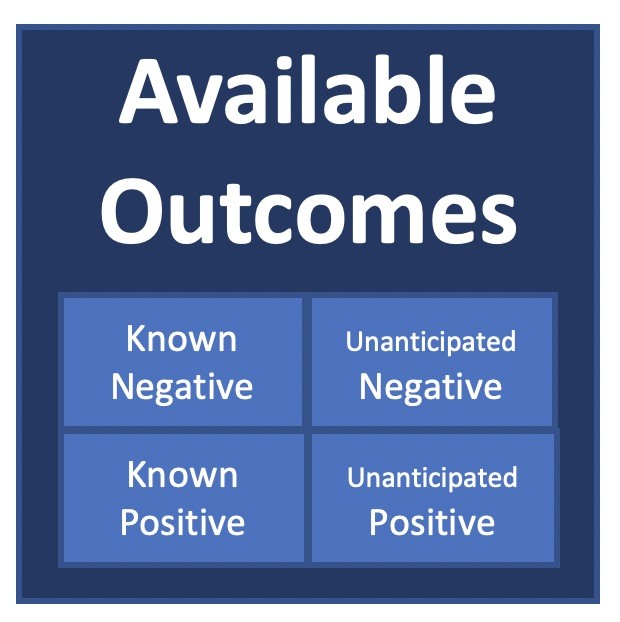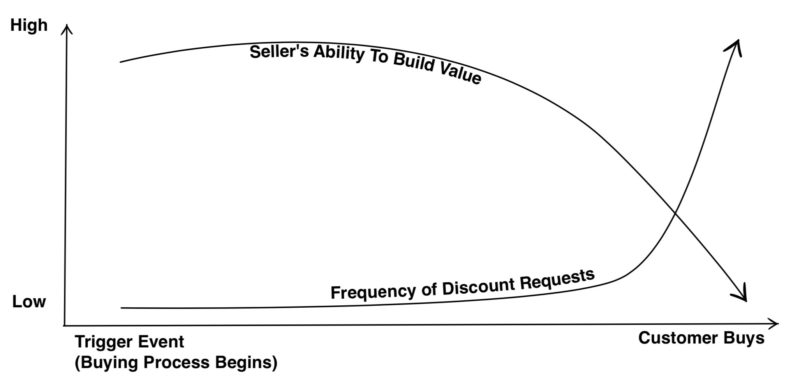
By Mark Boundy
The Time Value of Selling Value
The Time Value of Selling Value https://csuiteold.c-suitenetwork.com/advisors/wp-content/themes/csadvisore/images/empty/thumbnail.jpg 150 150 Mark Boundy https://secure.gravatar.com/avatar/fda1708afcd4681826f4fb12f56401d9?s=96&d=mm&r=g
You are probably aware of the time value of money, but did you know that there is also a time value of selling value?
In the finance world, when someone talks about the time value of money, they mean that a dollar received now is worth more than a dollar received in the future. This is true even when that future dollar is absolutely a sure thing. The idea is that you could invest today’s dollar and have more money than if you had gotten one dollar in the future.
In the sales world, building value early in your customer’s buying process pays more than building value late. A customer’s mind is more receptive to placing value on a solution before they have started on the price justification/negotiation stage of their buying process. The time value of selling value holds true even if your solution is not fully defined, as long as an outcome they will achieve is.
Let’s unpack this by looking at how value builds in the customer’s mind.
Value is About Differentiated Outcomes
Customers don’t buy your product or service. They buy outcomes. Customers buy for their own reasons, not necessarily the ones you gave them to buy.
Every purchase decision depends upon a customer connecting an offer to an outcome they desire. No outcome, sale.
There are four kinds of outcomes, illustrated below: Outcomes are either negative (pain) or positive (opportunities). There are known/expected outcomes and those a customer hasn’t envisioned yet (but which a trusted advisor might open their eyes to). The old sales training advice about “uncovering pain points” covers only one of the four quadrants above (top left). Think of all the potential value you miss when all your salespeople do is go after this low-hanging fruit. As bad as that sounds, it gets worse. This quadrant is where all of your competitors swarm. Differentiation is often minimal here. When all competitors look the same, guess what the customer’s decision comes down to (spoiler alert: it involves getting ground down mercilessly on price).

Value is About Expected Outcomes
Also, customers don’t buy “you” (I get the value of credibility, but if your offer doesn’t accomplish anything for a customer, it doesn’t matter how much they “know, like, and trust” you). Customers buy an expected result. Thus, “expected” is where your credibility comes in. Value, therefore, grows as faith in an outcome grows. Personal credibility and proof documentation helps builds belief/faith in an outcome…no more, no less.
Value also grows as the picture of that outcome becomes more clear and detailed — in the customer’s mind. Contrary to what “rational model” economic theory predicts, real customers don’t automatically hear an outcome described and engage in detailed self-analysis of all financial impacts of any individual outcome…much less all of the outcomes available. Accomplished value sellers help prospects build detailed mental pictures…envisioning themselves achieving outcomes and follow-on outcomes. Some trainers call this “selling beyond the sale”. Telling stories is a great way to kickstart this process, but personalization should follow.
Value, by Definition, is Desirability of Expected Outcomes
After envisioning comes evaluating the desirability of outcomes. Desire is good. Strong desire is better. Desire one can justify to one’s peers in a complex sale is…power. Specifically, it’s pricing power.
Elite selling involves guiding a customer through a process of measuring the desire for an outcome monetarily. Once desirability is measured in dollars, euros, yen, etc., value comes into full form. You and your customer can confidently discuss price against a known, quantified value. Discounting is less frequent. More importantly, your price exception/discounting process becomes more disciplined and objective.
Timing is Everything in Selling Value
Selling value is the art of building a detailed, monetized picture of outcomes in each prospect’s mind. Let’s look at the components of value-building at different stages in the customer’s buying process (aka the customer journey).
- Imagine building credibility near the beginning of the customer’s buying journey. Now imagine trying to build it late.
- Imagine helping them envision unexpected outcomes early. Now imagine trying to do it while they are comparing proposals against each other.
- Imagine showing proof of an outcome early…versus doing it to combat discounting pressure.
- Imagine asking them to envision all of the follow-on/related results early…versus late.
- Imagine talking to a customer about the annual cost impact of some challenges they are experiencing. What does that feel like to a customer during discovery…and what does it feel like if you start exploring it during price negotiations?
How many opportunities in your funnel right now are you feeling worse about? Did this just make you second-guess your forecast? If we could get your salespeople to build value early, what do you think would happen to 1) probability of winning 2) need to discount?

The graph above illustrates that the opportunity to build value for your offer has pretty much passed right when customers start comparing offers and negotiating price.
Can you see why there is a time value to selling value?
Good News/Bad News
Ask your salespeople “what value does this customer see in our solution” as a sales coaching question. If your salespeople can articulate detailed value, they’ve covered all the steps above really well. In fact, you can probably enter a highly accurate forecast for that opportunity by looking at the total customer value versus your price.
It the salesperson can’t articulate clear value, they either haven’t sold value or your offer doesn’t have any (to that customer in that opportunity). In the former case, some high-impact coaching might rescue the deal if it’s early enough. In either case, a low-to-lost deal forecast might be the right course of action.
Want to talk about how to apply these principles in your sales team? Contact me. Also, feel free to like, share, or comment below.
To your success!

